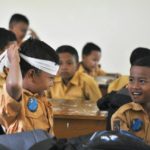 The expansion of education in developing countries has made considerable progress possible in terms of the access to education available to people. New research from IIASA highlights how this progress is not seen equally, however, and indeed, mere presence in school should not be confused with a quality education.
The expansion of education in developing countries has made considerable progress possible in terms of the access to education available to people. New research from IIASA highlights how this progress is not seen equally, however, and indeed, mere presence in school should not be confused with a quality education.
The researchers explain that the way we measure human capital is, in large part, unsatisfactory. They argue that most human capital indicators only consider education in terms of the number of years spent rather than any actual skills learned. Any that do focus on skills tend to extrapolate the skills of the working-age population from the skills of school-age students.
Rapid change
This, the authors argue, is a significant problem, especially in countries that have rapidly changed school systems. The paper documents how a growing number of countries are attempting to assess the literacy skills of their entire population, and to do so by age and sex.
This adult literacy data allows the authors to produce a demographically consistent indicator for adult literacy skills, which they call Skills in Literacy Adjusted Mean Years of Schooling (SLAMYS). The tool covers 1970 to 2015 and a total of 185 countries.
The study challenges the notion that the expansion of schooling in many developing countries has resulted in an increase in human capital, as countries that have expanded their formal education attainment levels have not seen a corresponding rise in literacy levels. This, the authors believe, highlights the widening skills gap between high- and low-performing countries.
Attainment gap
“While developing countries are rapidly catching up in terms of formal educational attainment, the gap between highly skilled and low skilled populations continues to widen globally—it has in fact increased to the equivalent of over 10 years of schooling. In addition, there are considerable differences in trends between countries and regions. Finland, Japan, and South Korea have for instance seen remarkable increases in their SLAMYS since 1970,” the authors explain. “On the other hand, many countries in Africa and South Asia have achieved rather good progress in terms of conventional mean years of schooling, but only marginal increases in their SLAMYS. There is significant heterogeneity across continents and regions.”
In order to accurately gauge human capital across the population, the researchers urge policymakers to look beyond the quantity of education and also assess the quality, both of the education and the skills that result from it. This is especially important as society transforms into the knowledge economy and advanced skills are crucial for success.
“The widening global gap in the literacy skills of the working-age population will have significant implications for disparities among countries in their economic development, health, and overall wellbeing in light of the current transition to knowledge societies and the digital revolution. Improving measures of human capital, as we have endeavored to do in this study, will help societies better monitor progress and advance policies that help to improve the skills that empower people around the world to improve their lives and help to advance their societies,” the authors conclude.